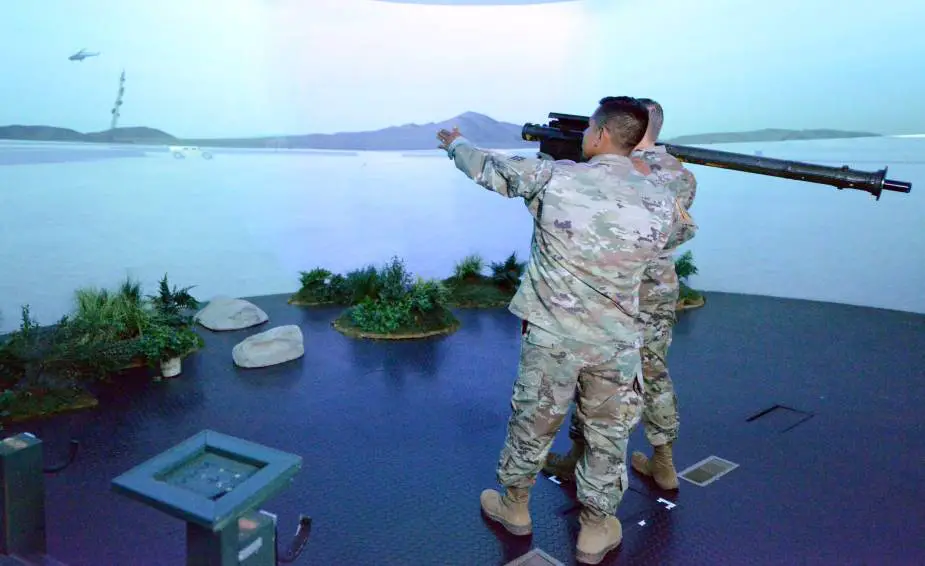Simulation modeling has been used by the military for long. Maneuvers, drills, command-staff exercises are held to simulate upcoming operations. Command-staff drills widely use large-scale mathematical and other models that reflect the connection between combat actions and their effectiveness factors. Lieutenant-Colonel PhD Technical Science N. Mustafayev, Lieutenant-Colonel R. Leontyev and expert Ye. Idilieva consider the role of simulation modeling at the 4th central range of the Russian Defense Ministry in an article in the Voennaya Mysl (Military Thought) journal.
Follow Army Recognition on Google News at this link

In the Stinger Dome, U.S. Army Staff Sgt. Ivan Peralta guides Sgt. 1st Class Arianna Cook as she aims a shoulder-fired Stinger missile at an enemy helicopter projected on the circular wall of the simulation center. (Picture source: U.S. Army)
The simulation modeling is the main form of a systemic analysis of combat effectiveness. The simulated developments usually proceed in a real order, but with a changed time scale. Random factors are registered by special sensors of random numbers (imitators). The simulation process can be suspended for an operational military game, expert poll or in-situ experiment with the use of intermediate data obtained by machine simulator.
The reliability of air defense weapon and hardware trials at ranges is provided if the tests take place in an environment, which is adequate to the environment in which they will operate. It means that a group of subordinates is necessary to interact with superior automatic systems in a corresponding air situation. However, in-situ trials with all the mentioned means demand major financial expenses are are sometimes totally impossible. Therefore, the theoretical method of tests has occupied a major place in range trials in the past decades.
The theoretical method tests the compliance of most arms and hardware with the technical assignment by means of modeling and the results are confirmed by a small scope of in-situ trials.
The two-word “simulation modeling” definition means the use of models, which cannot calculate and predict the result in advance. Therefore, an experiment or simulation of the functions with assigned primary data are necessary to study real arms and hardware. The semi-realistic simulation modeling in the 4th central range includes an upgraded complex simulation modeling device (KIMU), which comprises a complex stationary modeling unit, a mobile and portable modeling unit.
The idea to use models at the range appeared in 1950s during the trials of the first antiaircraft complexes. It was due to two reasons: firstly, the characteristics of the aircraft engaged as targets were limited (speed, altitude, maneuvering intensity, etc.) and did not allow testing the weapon in the assigned range of conditions, and secondly, the cost of aviation provision was high.
As the number and sophistication of tested weapons increased, the role of modeling methods and their engagement sphere expanded. The 1987-1990 modeling complex of the range was considerably upgraded. In 1991, the work began jointly with the Moscow Research Institute of Device Automatics (MNIIPA) to upgrade and expand KIMU capabilities and switch it to a new element base.
It was decided in 2001 to specify the design of KIMU-2000. The deployment of the first line of KIMU-2000 began, as well as software development and preparations for preliminary and inter-departmental trials. In 2001, the mockup included a group messaging device (GUPS) — a multiplexor with eight channels connected with the tested antiaircraft weapon. The KIMU-2000 mockup was interfaced with automatic Fundament-3 complex and used in trials.
In 2002, the assembly and tuning of KIMU-2000 technical means began and the complete concept of KIMU-2000 was specified.
In 2003-2004, successful preliminary and then inter-departmental trials of the first KIMU-2000 line were held. They provided a preliminary conclusion about the possibility to use the first line for trials of antiaircraft arms, as well as recommendations to upgrade KIMU-2000 hard and software.
© Copyright 2021 TASS / Army Recognition Group SPRL . All rights reserved. This material may not be published, broadcast, rewritten or redistributed.














